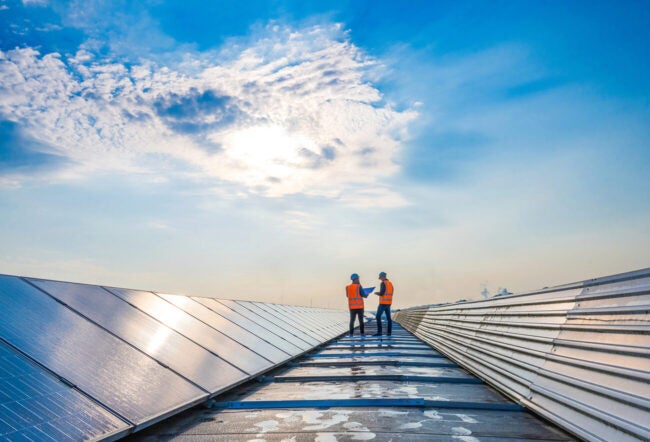The greening of America’s sports facilities is already having direct influence on the health of the environment. But that impact is dwarfed by the potential of sports greening to affect the attitudes and behavior of fans throughout the country. As Allen Hershkowitz, a senior scientist at the Natural Resources Defense Council (NRDC), routinely reminds his colleagues, given how many Americans follow sports and how few follow science, “climate deniers can attack the EPA with impunity, but they cannot attack MLB, the NHL, the NBA or NASCAR, which have all indicated a concern about the effects of global warming on their sport.”
Hershkowitz was among the speakers at a recent conference titled, “Leadership in Greening the Sports Industry,” sponsored jointly by Wharton’s Initiative for Global Environmental Leadership (IGEL) and the NRDC. This article includes information from the conference held at Wharton, as well as insights gathered from additional industry leaders.
According to Kenneth L. Shropshire, a Wharton legal studies and business ethics professor and director of the Wharton Sports Business Initiative, “The key with sports is not just the impact on the venues, but the impact on those who attend the events, view, read and listen to sports.” Starting with Jackie Robinson, sports have played a profound role in moving American culture forward, notes Shropshire. “The impact beyond the game has been seen in issues from race and gender to the more direct issues of teamwork and leadership,” he adds.
During the conference, Frances Beinecke, president of the NRDC, said that it is not possible to make a significant difference “if we do not have the public with us.” Pointing to sports’ huge popularity in the U.S., she noted: “We work on [these issues] every day, but we need the [support of the] broader general public, and that’s where the sports greening effort is so important.”
“… [C]limate deniers … cannot attack MLB, the NHL, NBA or NASCAR, which have all indicated a concern about the effects of global warming on their sport.” — Allen Hershkowitz
Measurable and Immeasurable
Given the number of people who attend sporting events in this country each year (close to 300 million in 2005, according to a study by the North American Association of Sports Economists), the potential impact of green sports facilities on fans is large. The process of measuring that impact is just getting started.
The chemical giant BASF began surveying Seattle Mariners fans in 2012 to evaluate the success of the company’s partnership with the team’s zero-waste program. BASF is interested in assessing more than just the marketing effectiveness of the partnership. The company also wants to know “if it is helping people be more sustainable at home,” says Christopher Bradlee, market development manager for BASF’s line of biopolymers in North America.
“Certainly we can measure success from a business standpoint by looking at economic indicators,” adds Bradlee. “But the social indicators of how people are integrating this into their homes and work environments are very important to us.” To get a handle on this, BASF is partnering this fall with the city of Seattle to field a new survey designed to measure the effect on fans’ attitudes and behavior.
The results of the BASF survey aren’t yet in, but the results of another study undertaken at the university level by Jonathan Casper, a professor at North Carolina State University (NCSU), were published in 2012 in the Journal of Sport Management. Casper surveyed fans who had attended a green-themed NCSU football game. Seventy-five percent of the 2,700 who responded said that they would be more active in recycling in their everyday lives as a result of sports greening. Responses were similar when fans were asked about increasing their involvement in energy conservation, biking, the use of compostables and picking up litter.
It is tempting to attribute the impact on fans primarily to the announcements and signage at stadiums — on everything from scoreboards to food containers. But Martin Tull, executive director of the Green Sports Alliance, suggests that many of the attitudes and much of the behavior that fans pick up is simply the result of attending games at green stadiums where recycling and composting bins abound. The Alliance is a nonprofit that helps sports teams, venues and leagues enhance their environmental performance.
“Every time the fan touches that cup and then has to make a choice about where it goes, you’re normalizing the behavior that recycling is responsible.”— Martin Tull
“Every time the fan touches that cup and then has to make a choice about where it goes, you’re normalizing the behavior that recycling is responsible, and should be done throughout the community,” Tull says. “If you experience these types of conservation efforts in person at a sports venue, it starts to feel like that is becoming more the norm. I think that can be a really powerful point of inspiration for people.”
According to Alice Henly, resource specialist and coordinator of college sports greening at the NRDC (and author of its “Collegiate Game Changers” report), people are now coming to expect greener stadiums, which encourages them to regard “green infrastructure, green operations and green policy in sports venues as the new norm.”
Green stadiums do more than make recycling and composting seem normal; by setting an example in the parks of beloved home teams, green sports draws on a deep well of trust. NRDC’s Hershkowitz points to the importance of this trust in propelling the kind of mass movement that is needed to make a difference.
“We need a cultural shift in the way people think about the planet,” says Hershkowitz. “We need a cultural shift in attitudes and expectations about our relationship to the earth. And cultural shifts occur not because governments lead the way, but because people connect with trusted networks, people they believe and trust. Sports is one of those trusted networks.”
This trust can help move people beyond political ideologies and ingrained attitudes. Indeed, Tull adds that the very term climate change “brings up all kinds of political issues and baggage. Focusing on outcomes has been more important.” But because sports is a trusted network, Hershkowitz says, “when you go to a game and you see something about recycling or climate change or water conservation, and it’s done by the New York Yankees or the Boston Bruins or the Miami HEAT, you don’t see it as a political statement.”
Reaching Beyond Stadiums
But much of the greening that influences fans attending games goes unnoticed by the far greater audience watching the games on TV or listening to the play-by-play on radio or via the Internet.
The potential of reaching this huge audience has not gone unnoticed by the NRDC, the Alliance and the individual teams and leagues involved in the greening of sports. Two NRDC-produced public service announcements promoting recycling, water conservation and environmental stewardship in general were broadcast in 2012 by the NBA and the NHL on ESPN, ABC TV, NBC Universal, TBS and TNT.
“Those two commercials alone were seen by almost 45 million people in one week,” says Hershkowitz, adding, “We have produced public service announcements that have reached over 100 million people.” For its part, NASCAR Green has aired a 30-second spot that “was seen by 10 million viewers every week for 38 weeks,” Mike Lynch, managing director of green innovation at NASCAR noted during the conference.
And these viewers are not the usual audiences environmental groups talk to, according to Hershkowitz. “Look at the markets we’re going into — Charlotte, St. Louis, Cleveland, Columbus, Pittsburgh, Houston, Kansas City, Memphis. We are in all those markets. We are reaching middle America in a way that our traditional environmental advocacy strategies never allowed us to do.”
The green outreach extends to the small screen as well. NBA Green, NHL Green, NASCAR Green, the Portland Trail Blazers, the Seattle Mariners and many others have active websites devoted to sustainability. And virtually all of the teams, leagues and venues engaged in greening sports are using social media to further that goal.
Mainstream media has also helped extend the reach of the sports greening initiatives. According to Henly, TV interviews with supportive commissioners, owners and players are available for viewing online, and the press, both online and in print, has covered everything from the installation of a large wind turbine at the Cleveland Indians’ Progressive Field to a bike program at games for the Dynamos, a professional soccer team that plays at BBVA Compass Stadium in Houston.
Press coverage of sports greening is already well established. Back in 2007, Sports Illustrated editors responded to numerous presentations by the NRDC and ran a cover story on “Sports and Global Warming: As the Planet Changes So Do the Games We Play — Time to Pay Attention.” Even when the coverage is less than hoped for, it often advances the cause. Scott Jenkins, vice president of ballpark operations for the Seattle Mariners, recalled that when the stadium first started giving fans the option to purchase Safeco field soil (from park composting), commentators on ESPN joked about the team “handing out manure.” But Jenkins was still pleased. “At least we got those guys talking about recycling and environmental issues.”
No one has yet figured out a way to fully and accurately measure the impact of these efforts, either in the ballparks and through the media. Hershkowitz has spoken to major corporations that have sponsored sports for decades, and even they struggle to discern how their sponsorships affect customers’ attitudes and behavior. “It’s the holy grail of measurement, to watch that transition from leadership at a venue, at a culturally iconic building, to the community at large and to households,” Henly notes.
But as Hershkowitz adds, “just because it’s not measurable, doesn’t mean it’s not important.”
With millions of fans growing accustomed to recycling and composting at their home team stadiums, and with millions more engaging with their teams green messaging through online and on-air media, greening through sports increasingly serves as a wedge that is raising public awareness about environmental protection.



